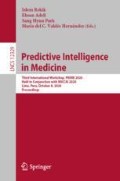Abstract
Generative Adversarial Networks (GANs) have increasingly broken records in solving challenging medical image analyses problems such as medical image de-noising, segmentation, detection, classification or reconstruction. However, to the best of our knowledge, they have not been used for female pelvic multi-organ segmentation. Accurate segmentation of uterine cervical cancer (UCC) organs (i.e., bladder, vagina and tumor) from magnetic resonance imaging (MRI) is crucial for effective UCC staging. However, it is a highly challenging task due to 1) noisy MR images, 2) within-subject large variability in structure and intensity of UCC organs, and 3) across-subject variability. More importantly, there have been very limited works on how to aggregate different interactions across MRI views using GANs for multi-organ segmentation while providing context information. In this work, we propose a novel synergetic multiplex network (SMN) using multi-stage deep learning architecture based on cycle-GAN to segment pelvic multi-organ using complementary multi-view MRI, introducing three major contributions in multi-organ segmentation literature: (1) Modeling the interactions across data views using a novel multiplex architecture composed of multiple layers. Each SMN layer nests a cascade of view-specific context-aware cycle-GANs and synergistically communicates context information to other paralleled view-specific layers via multiplex coupling links. (2) SMN captures shared and complementary information between different views to segment UCC in different MRI views. (3) It enforces the spatial consistency between neighboring pixels within the same tissue for UCC segmentation. Specifically, in a gradual and deep manner, the proposed method improves the segmentation results by iteratively providing more refined context information from other views to train the next segmentation cycle-GAN in the SMN layer. We evaluated our SMN framework using 15 T2w-MR sequences with axial and sagittal views. We show that SMN is robust for the UCC segmentation task by significantly (\(p<0.05\)) outperforming comparison segmentation methods.
Access this chapter
Tax calculation will be finalised at checkout
Purchases are for personal use only
References
Bray, F., Ferlay, J., Soerjomataram, I., Siegel, R.L., Torre, L.A., Jemal, A.: Global cancer statistics 2018: GLOBOCAN estimates of incidence and mortality worldwide for 36 cancers in 185 countries. CA Cancer J. Clin. 68, 394–424 (2018)
He, K., Cao, X., Shi, Y., Nie, D., Gao, Y., Shen, D.: Pelvic organ segmentation using distinctive curve guided fully convolutional networks. IEEE Trans. Med. Imaging 38, 585–595 (2018)
Kazemifar, S., et al.: Segmentation of the prostate and organs at risk in male pelvic CT images using deep learning. Biomed. Phys. Eng. Express 4, 055003 (2018)
Litjens, G., et al.: A survey on deep learning in medical image analysis. Med. Image Anal. 42, 60–88 (2017)
Trullo, R., Petitjean, C., Dubray, B., Ruan, S.: Multiorgan segmentation using distance-aware adversarial networks. J. Med. Imaging 6, 014001 (2019)
Dong, X., et al.: Automatic multiorgan segmentation in thorax CT images using U-net-GAN. Med. Phys. 46, 2157–2168 (2019)
Lei, Y., et al.: Male pelvic multi-organ segmentation aided by CBCT-based synthetic MRI. Phys. Med. Biol. 65, 035013 (2020)
Lei, Y., et al.: Deep learning in multi-organ segmentation. arXiv preprint arXiv:2001.10619 (2020)
Zhu, J.Y., Park, T., Isola, P., Efros, A.A.: Unpaired image-to-image translation using cycle-consistent adversarial networks. In: Proceedings of the IEEE International Conference on Computer Vision, pp. 2223–2232 (2017)
Huo, Y., Xu, Z., Bao, S., Assad, A., Abramson, R.G., Landman, B.A.: Adversarial synthesis learning enables segmentation without target modality ground truth. In: IEEE 15th International Symposium on Biomedical Imaging (ISBI 2018), pp. 1217–1220 (2018)
Kang, E., Koo, H.J., Yang, D.H., Seo, J.B., Ye, J.C.: Cycle-consistent adversarial denoising network for multiphase coronary CT angiography. Med. Phys. 46, 550–562 (2019)
Chen, C., Dou, Q., Chen, H., Heng, P.-A.: Semantic-aware generative adversarial nets for unsupervised domain adaptation in chest x-ray segmentation. In: Shi, Y., Suk, H.-I., Liu, M. (eds.) MLMI 2018. LNCS, vol. 11046, pp. 143–151. Springer, Cham (2018). https://doi.org/10.1007/978-3-030-00919-9_17
Dar, S.U., Yurt, M., Karacan, L., Erdem, A., Erdem, E., Çukur, T.: Image synthesis in multi-contrast MRI with conditional generative adversarial networks. IEEE Trans. Med. Imaging 38, 2375–2388 (2019)
Bnouni, N., Rekik, I., Rhim, M.S., Amara, N.E.B.: Dynamic multi-scale CNN forest learning for automatic cervical cancer segmentation. In: Shi, Y., Suk, H.-I., Liu, M. (eds.) MLMI 2018. LNCS, vol. 11046, pp. 19–27. Springer, Cham (2018). https://doi.org/10.1007/978-3-030-00919-9_3
Badrinarayanan, V., Kendall, A., Cipolla, R.: SegNet: a deep convolutional encoder-decoder architecture for image segmentation. IEEE Trans. Pattern Anal. Mach. Intell. 39, 2481–2495 (2017)
Ronneberger, O., Fischer, P., Brox, T.: U-Net: convolutional networks for biomedical image segmentation. In: Navab, N., Hornegger, J., Wells, W.M., Frangi, A.F. (eds.) MICCAI 2015. LNCS, vol. 9351, pp. 234–241. Springer, Cham (2015). https://doi.org/10.1007/978-3-319-24574-4_28
Kanawati, R.: Multiplex network mining: a brief survey. IEEE Intell. Inf. Bull. 16, 24–27 (2015)
Lee, K.M., Kim, J.Y., Lee, S., Goh, K.I.: Multiplex Networks. Networks of Net-works: The Last Frontier of Complexity, pp. 53–72 (2014)
Bnouni, N., Rekik, I., Rhim, M.S., Amara, N.E.B.: Cross-view self-similarity using shared dictionary learning for cervical cancer staging. IEEE Access 7, 30079–30088 (2019)
Author information
Authors and Affiliations
Corresponding author
Editor information
Editors and Affiliations
Rights and permissions
Copyright information
© 2020 Springer Nature Switzerland AG
About this paper
Cite this paper
Bnouni, N., Rekik, I., Rhim, M.S., Ben Amara, N.E. (2020). Context-Aware Synergetic Multiplex Network for Multi-organ Segmentation of Cervical Cancer MRI. In: Rekik, I., Adeli, E., Park, S.H., Valdés Hernández, M.d.C. (eds) Predictive Intelligence in Medicine. PRIME 2020. Lecture Notes in Computer Science(), vol 12329. Springer, Cham. https://doi.org/10.1007/978-3-030-59354-4_1
Download citation
DOI: https://doi.org/10.1007/978-3-030-59354-4_1
Published:
Publisher Name: Springer, Cham
Print ISBN: 978-3-030-59353-7
Online ISBN: 978-3-030-59354-4
eBook Packages: Computer ScienceComputer Science (R0)


